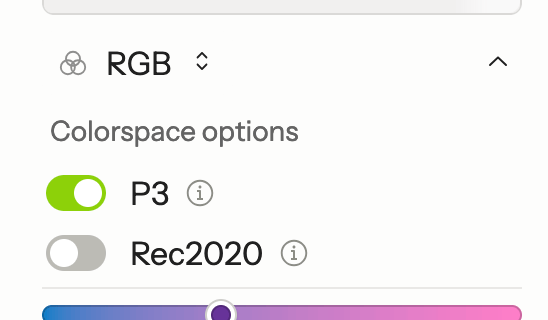React Color Picker
Most color pickers are steeped in the past with limited gamuts and color spaces. Now that CSS Color Module 4 and higher-gamut colors are widely-available to users, color pickers need to update.
But not only that, in order to display colors in non-sRGB color spaces, WebGL is needed to recreate colors accurately. Most color pickers use CSS Gradients to simulate colors, which can achieve “good enough” accuracy for sRGB, but not for anything else.
| Feature | Terrazzo | react-color | @rc-component/color-picker | react-colorful | react-aria |
|---|---|---|---|---|---|
| WebGL | ✅ | ❌ | ❌ | ❌ | ❌ |
| > 8bit depth | ✅ | ❌ | ❌ | ❌ | ❌ |
| P3 Gamut | ✅ | ❌ | ❌ | ❌ | ❌ |
| Rec2020 Gamut | ✅ | ❌ | ❌ | ❌ | ❌ |
| OKLAB/OKLCH | ✅ | ❌ | ❌ | ❌ | ❌ |
Demo
Setup
npm i @terrazzo/react-color-picker @terrazzo/use-colorpnpm i @terrazzo/react-color-picker @terrazzo/use-colorimport ColorPicker from "@terrazzo/react-color-picker";
import useColor from "@terrazzo/use-color";
export default function MyComponent() {
const [color, setColor] = useColor("#ff0000");
return <ColorPicker color={color} setColor={setColor} />;
}Methodology
The following decisions went into making Terrazzo’s color picker as good as it can be.
Sliders: accuracy
As pointed out in Björn Ottosen’s—the creator of OKLAB/OKLCH—fantastic article about color pickers, there’s a tension between accurate color pickers being hard to use, while user-friendly color pickers aren’t precise.
While his solution of an OKHSL color picker is a great compromise, it limits color picking to that color space alone. In order to be universally-usable for all color spaces, per-channel sliders are needed for control.
Percentages: higher bit depth
Bit depth is different than gamut. A higher gamut color is more vibrant; a higher bit depth color is more precise.
Even people that have worked with RGB color a long time may not realize that integers 0-255 can’t support higher bit depth (in fact, 28, or 256, is what locks the colors into 8 bit depth).
This matters because in between, say, rgb(0, 0, 0) and rgb(1, 1, 1), users may have a monitor that can display rgb(0.5, 0.5, 0.5), but you won’t be able to access that color without expressing it as a percentage: rgb(0.2% 0.2% 0.2%). Why simply not use half the colors a user’s monitor can display, just because of your color tools?
Hex codes are also locked into 8 bit depth, because they’re still the 28 colors just shortened into hexadecimal. Currently the only way to express higher bit depth is with percentages.
The Terrazzo color picker uses percentages so it’s future-proof and can express colors with any degree of accuracy needed for any monitor.
Toggles: gamut
sRGB, Display P3, and Rec 2020 (upcoming) gamuts in comparison. Each is significantly larger than the last. From Wikipedia.
By default, all color spaces are clamped to the sRGB gamut, which is the smallest but is available for all users on all devices. The expanded Display P3 gamut—common but not quite 100% of all users and devices—has to be manually-enabled in the expanded options. The Rec2020 gamut, the largest one, isn’t yet available on the web, but it’s included for futureproofing this color picker for the day when it does become available.

Any gamuts that are toggled off won’t be reachable with the sliders. This ensures you’re not selecting colors outside the range of what’s intended.
API
Props
| Name | Type | Description |
|---|---|---|
color | Color | A color object from @terrazzo/use-color |
setColor | (color: Color) => void | A setter function for the color object |
use-color
The @terrazzo/use-color hook lets you memoize a color using Culori for fast, scientifically-accurate color operations.
import useColor, { formatCss } from "@terrazzo/use-color";
const [color, setColor] = useColor("#ff0000");
console.log(color.original); // { mode: "rgb", r: 1, g: 0, b: 0 }
console.log(color.css); // color(srgb 1 0 0)
console.log(color.p3); // { mode: "p3", r 0.9175, g: 0.2003, b: 0.1386 }
console.log(color.oklab); // { mode: "oklab", r: 0.628, g: 0.22, b: 0.13 }
console.log(color.oklch); // { mode: "oklch", r: 0.628, g: 0.257, b: 29.234 }
console.log(formatCss(color.oklab)); // color(oklab 0.628 0.22 0.13)Colorspaces
The color object can convert to any CSS Color Module 4 color space using a memoized getter (meaning the work isn’t done until the color space is requested, and subequent requests are cached).
| Name | Type | Description |
|---|---|---|
color.original | object | A Culori Color object |
color.css | string | A CSS Color Module 4 color string |
color.a98 | object | Culori Adobe RGB 98 object |
color.hsl | object | Culori HSL object |
color.hsv | object | Culori HSV object |
color.hwb | object | Culori HWB object |
color.lab | object | Culori CIEL*a*b* object |
color.lch | object | Culori CIEL*c*h* object |
color.lrgb | object | Culori Linear RGB object |
color.okhsl | object | Culori Okhsl object |
color.okhsv | object | Culori Okhsv object |
color.oklab | object | Culori Oklab object |
color.oklch | object | Culori Oklch object |
color.p3 | object | Culori P3 object |
color.prophoto | object | Culori Protophoto RGB object |
color.rec2020 | object | Culori Rec2020 RGB object |
color.rgb | object | (alias for srgb) |
color.srgb | object | Culori sRGB object |
color.xyz | object | (alias for xyz65) |
color.xyz50 | object | Culori XYZ D50 object |
color.xyz65 | object | Culori XYZ D65 object |
There’s also a formatCss() helper that’s similar to Culori’s but rounds numbers slightly (without losing accuracy) for a cleaner, easier-to-copy string.